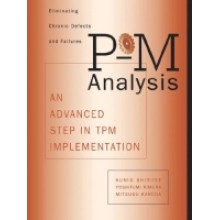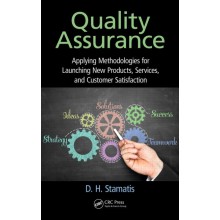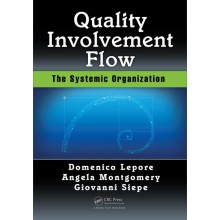Performance Acceleration Management (PAM): Rapid Improvement to Your Key Performance Driver
ISBN: 9781466572577
Author: H. James Harrington
Dispatch Time: 15 - 30 Days
Quantity:
Add to Compare
The first book in the Little Big Book Series, Performance Acceleration Management (PAM): Rapid Improvement to Your Key Performance Drivers, explains how to accelerate the rate of change and improvement in your organization to exceed your customers’ expectations. It introduces the PAM approach to accelerated performance improvement and explains how to use it to bring about significant change to your organization’s long-term performance. Supplying answers to commonly asked questions, the book provides you with the understanding to:
- Conduct an improvement requirements assessment
- Define key drivers and develop vision statements for each
- Define desired behavioral patterns and performance goals
- Develop individual key performance driver (KPD) transformation plans
- Develop and implement a five-year combined PAM plan
- Obtain approval from the executive team
Delving into more than 50 years of experience helping organizations implement improvement approaches, H. James Harrington highlights key opportunities to add value to your organization. With over 1,400 different improvement tools available today, this book provides a set of tools to define how you want to change your organization’s key performance drivers and then develop a customized accelerated approach to achieve the desired transformation.
Table of Contents
Performance Acceleration Management: Its Theory and Practice
Performance Improvement Plan versus Business Plan
Why Do You Need a Detailed Plan to Manage Performance Improvement?
What Factors Affect an Organization’s Culture?
What Are the Key Performance Drivers?
The Performance Acceleration Management Approach
Phase I: Conducting an Improvement Requirements Assessment
Phase II: Developing Vision Statements
Phase III: Defining Desired Behavioral Patterns and Performance Goals
Defining Desired Behavioral Patterns
Defining Performance Goals
Phase IV: Developing Individual KPD Transformation Plans
Phase V: Developing a Five-Year Combined PAM Plan
Phase VI: Implementing the Combined PAM Plan
Phase VII: Continuously Improving
Phase I: Conducting an Improvement Requirements Assessment
Activity One: Organize for Performance Acceleration
Activity Two: Define Present Status and Improvement Opportunities
One-on-One Personal Interviews with Each
Member of the Executive Team
Focus Groups with Middle Managers, First-Line Managers, and Employees
Researching Available Documentation
Phase I Final Report
Summary
Phase II: Developing Vision Statements
Overview of Phase II
Offsite Meeting of the Steering Committee
Activity One: Review and Upgrade, If Necessary, the Organization’s Mission Statement, Values, and Vision
Activity Two: Review the Assessment Report Prepared during Phase I
Activity Three: Define the AS IS Description for Each KPD
Activity Four: Develop Preliminary KPD Vision Statements
Activity Five: Conduct Focus Groups
Activity Six: Conduct and Analyze an Organizational Change Management Survey
Activity Seven: Prepare the Final KPD Vision Statements
Activity Eight: Communicate Final KPD Vision Statements
Phase III: Defining Desired Behavioral Patterns and Performance Goals
Defining Desired Behavioral Patterns
Activity One: Define the Desired Behaviors/Habits Related to the Vision Statements
Activity Two: Define the Desired and Undesired Behaviors/Habits Related to the Activities as Performed within the Organization
Activity Three: Define How to Measure Desired Behavioral Patterns
Defining Performance Goals
Activity Four: Define Key Performance Measurements
Activity Five: Define Present Performance Levels of the Key Performance Measurements
Activity Six: Define Competitors’ Present Performance Level for the Key Performance Measurements
Activity Seven: Project Competitors’ Performance Level for the Key Performance Measurements
Activity Eight: Finalize the Key Performance Goals for the Next Five Years
Phase IV: Developing Individual KPD Transformation Plans
Planning versus Problem Solving
Activity One: Assign a Planning Team (Subcommittee) to Each KPD Vision Statement to Develop an Individual Transformation Plan
Activity Two: Define Present-Day Problems
Activity Three: Define Roadblocks to Evolving to the Desired Future-State Vision
Activity Four: Select Tools/Methodologies to Address Defined Problems and Roadblocks
Factors Impacting the KPD Transformation Plans
Frequently Used Tools for Manufacturing Process Vision Statement
Frequently Used Tools for Business Process
Improvement Vision Statement
Frequently Used Tools for Customer/Consumer Partnership Vision Statement
Frequently Used Tools for Management Support/Leadership Vision Statement
Frequently Used Tools for Supplier Partnership Vision Statement
Frequently Used Tools for Total Quality Management System Vision Statement
Assign a Knowledgeable Performance Improvement Specialist
Activity Five: Develop an Implementation Timeline Chart for Each Tool/Methodology
Activity Six: Obtain Approval of the Individual KPD Transformation Plan
Phase V: Developing A Five-Year Combined PAM Plan
Activity One: Define Resource Constraints
Activity Two: Define Interrelated Tools/Methodologies
Activity Three: Prioritize Individual Tools/Methodologies
Activity Four: Combine the Individual KPD Transformation Plans into the Pam WBS
Preparing a Five-Year Work Breakdown Structure
Phase VI: Implementing the Combined PAM Plan
Activity One: Develop Individual Detailed Implementation Plans for Each Tool/Methodology
Activity Two: Combine the Individual Detailed Implementation Plans into a Rolling 90-Day WBS
Activity Three: Prepare a Three-Year Financial Plan to Fund the PAM Project
Activity Four: Establish the Tracking System to Ensure the Project Is on Schedule, within Costs, and Will Produce the Desired Results
Activity Five: Establish a Measurement System That Will Measure the Impact the Project Is Having on the Organization’s Performance
Activity Six: Evaluate Contributions Made by Individuals, Groups, and Teams, and Recognize Outstanding Performance
Phase VII: Continuously Improving
The Next Cycle of PAM
Organizational Master Plan
Two Major Continuous Improvement Methodologies
Area Activity Analysis
The Seven Phases of AAA
Organization Alignment
Phase I: Strategic Plan
Phase II: Processes and Networks Design
Phase III: Organizational Structure Design
Phase IV: Staffing Phase
Phase V: Rewards and Recognition
Phase VI: Implementation
PAM Process Summary
Appendix A: Definition and Abbreviations
Appendix B: List of over 1,400 Different Performance Improvement Tools and Methodologies
Appendix C: Tools/Methodologies Interaction between KPDs
Index
Each chapter includes an introduction, summary, and references
Copyright © 2014 Engineering Standards Bureau. All Rights Reserved.
Developed By Zoom Into Web







